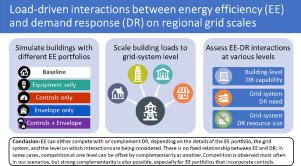Energy efficiency (EE) has long been recognized as a source of value to the electricity grid. Especially with increasing penetration of variable renewable generation, demand response (DR) can also provide system value and support the evolving needs of the grid. Yet there has been little study to date of interactions between EE and DR that may complicate their grid impacts. In this study we perform bottom-up modelling of the interactive effects between EE and DR in buildings for three representative regions of the United States electricity grid. Leveraging new simulation tools that enable detailed modelling of the building stock, we synthesize system-level demand profiles for several scenarios representing different portfolios of EE measures. In each scenario, we couple the underlying building models with a database of DR-enabling technologies to estimate building-level DR capabilities and compute a system-level supply curve for DR. We assess the resulting EE and DR interactive effects based on an existing conceptual framework. The results show a complex relationship between EE and DR, with interactive effects whose size and direction can vary widely depending on the grid system, type of DR, and the framework level being considered. Most often, the overall effect is competition between EE and DR, but significant complementarity can also occur, especially when the EE portfolio includes controls measures. Our results suggest that EE and DR programs developed without considering interactive effects may erode the benefits of both resources, whereas a more integrated approach may yield increased benefits.



